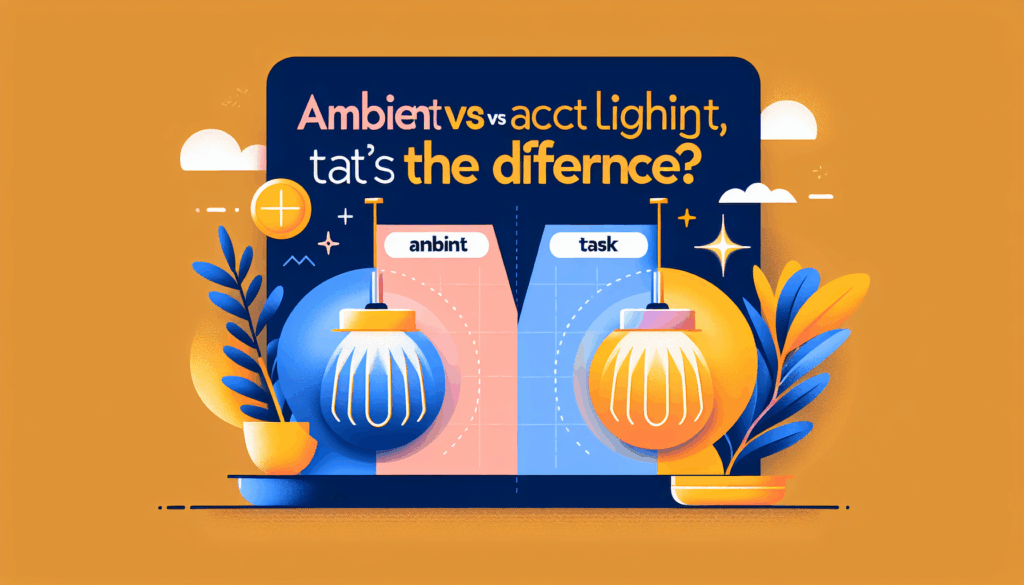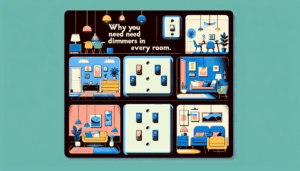Lighting is one of the most crucial elements in home design and interior decorating. It sets the mood, enhances functionality, and can dramatically alter the perception of space. Among the various types of lighting, three primary categories stand out: ambient, task, and accent lighting. Understanding the differences between these types of lighting is essential for creating a well-lit, inviting, and functional environment in your home or workspace. In this blog, we will explore each type of lighting in detail, discussing their characteristics, uses, and how to effectively incorporate them into your design.

What is Ambient Lighting?
Ambient lighting refers to the general illumination that fills a space, providing an overall light level that allows you to see and move around comfortably. Think of ambient lighting as the foundation of your lighting design. It creates a uniform light level without causing harsh shadows or glare, ensuring that your room feels warm and welcoming.
Characteristics of Ambient Lighting:
– Soft and Diffused: Ambient lighting is usually soft and diffused, preventing harsh contrasts in brightness.
– Comprehensive Coverage: It should provide adequate light to all areas of a room, enabling safe navigation and basic activities.
– Versatile Sources: Common sources of ambient lighting include ceiling-mounted fixtures, chandeliers, recessed lighting, and wall-mounted fixtures.
Uses of Ambient Lighting:
Ambient lighting is essential in every room of your home. In living rooms, it sets the overall mood for relaxation and socializing. In kitchens, it ensures that you can move safely while preparing meals. In bedrooms, ambient lighting creates a calming atmosphere conducive to rest.
Incorporating Ambient Lighting:
To effectively incorporate ambient lighting, consider the following tips:
– Layer Your Lighting: Combine various sources of ambient light to achieve a balanced look. For example, use ceiling fixtures along with floor lamps or wall sconces.
– Use Dimmer Switches: Installing dimmer switches allows you to adjust the brightness according to the time of day or activity, enhancing the versatility of your ambient lighting.
– Select the Right Bulbs: Opt for warm white bulbs (2700K to 3000K) for a cozy feel, or cooler bulbs (3500K to 4100K) for a more energizing atmosphere.
What is Task Lighting?
Task lighting is designed to illuminate specific areas where activities requiring greater focus and detail take place. This type of lighting is essential for performing tasks such as reading, cooking, studying, or working on hobbies.
Characteristics of Task Lighting:
– Focused and Direct: Task lighting provides concentrated light to specific areas, enhancing visibility and reducing eye strain.
– Adjustable: Many task lighting solutions are adjustable in angle or intensity, allowing you to direct light precisely where it’s needed.
– Variety of Sources: Common sources of task lighting include desk lamps, under-cabinet lights, pendant lights, and floor lamps.
Uses of Task Lighting:
Task lighting is particularly important in spaces like home offices, kitchens, and reading nooks. In a kitchen, under-cabinet lighting illuminates countertops for food preparation. In a home office, a desk lamp provides focused light for reading and writing.
Incorporating Task Lighting:
To effectively incorporate task lighting into your space, consider these strategies:
– Identify Key Areas: Determine where you need additional light for specific tasks, such as reading, cooking, or crafting.
– Select Adjustable Fixtures: Choose lamps or fixtures that can be adjusted for height or direction to provide the best illumination for your tasks.
– Combine with Ambient Lighting: Ensure that your task lighting complements your ambient lighting for a cohesive look and overall functionality.
What is Accent Lighting?
Accent lighting is used to highlight specific features or objects in a space, adding visual interest and depth. This type of lighting is often more dramatic and focused than ambient or task lighting, serving to create focal points within a room.
Characteristics of Accent Lighting:
– Dramatic and Focused: Accent lighting is intended to draw attention to specific areas or objects, such as artwork, architectural features, or plants.
– Higher Intensity: It is typically brighter than ambient lighting and can create strong contrasts, enhancing the visual appeal of the highlighted object.
– Variety of Sources: Common sources of accent lighting include track lighting, wall-mounted fixtures, spotlights, and decorative table lamps.
Uses of Accent Lighting:
Accent lighting can be used in various applications, such as showcasing artwork in a gallery wall, highlighting architectural details like arches or columns, or creating a cozy atmosphere around a fireplace.
Incorporating Accent Lighting:
To effectively incorporate accent lighting into your design, keep these tips in mind:
– Choose the Right Fixtures: Opt for adjustable fixtures that allow you to direct light precisely where you want it.
– Consider Contrast: Accent lighting should create contrast with ambient lighting to ensure that the highlighted object stands out.
– Layer with Other Lighting Types: Combine accent lighting with ambient and task lighting for a well-rounded approach that enhances the overall design.
Conclusion
Understanding the differences between ambient, task, and accent lighting is essential for creating a harmonious and functional lighting scheme in your home or workspace. By layering these three types of lighting, you can enhance the aesthetics of your space while ensuring it is practical for everyday use.
When designing your lighting plan, consider how each type of lighting serves its purpose within your environment. Whether you’re creating a cozy reading nook, a functional kitchen workspace, or a gallery-like atmosphere for your art collection, the right combination of ambient, task, and accent lighting can transform any space into a beautifully illuminated haven.
AI-Assisted Content Disclaimer
This article was created with AI assistance and reviewed by a human for accuracy and clarity.






Leave a Reply